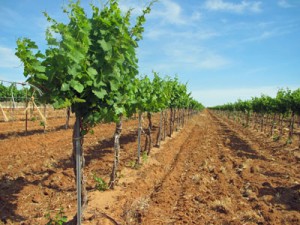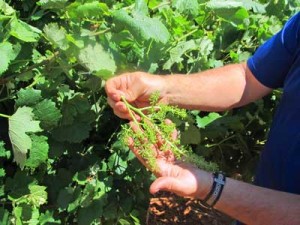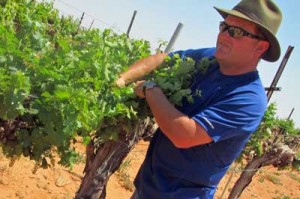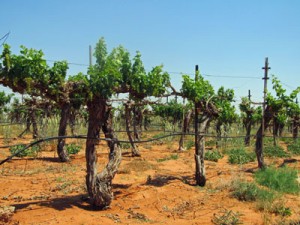A Brownfield Meet Up: A New Venture (Texas Custom Wine Works) Starts To Ferment
It all started one Friday morning this past May: a meet-up in a Wal-Mart parking lot in Brownfield, Texas, with Dusty Timmons. At the time, he was the Extension Viticulture Advisor for Texas’s Western Region (our largest that on average produces about 80 percent of the wine grapes in this state). But now, I imagine resulting at least in part from Texas uncertain grape future, today that’s all changed.
Dusty has teamed up with colleagues Mike Sipowicz (Winemaker), Dr. Steve Talcott (Food/Beverage Scientist), and Jet Wilmeth (commercial Texas grape grower – Diamante Doble Vineyard), on a new venture that could well change the course of human (and grape/wine producing) events in Texas. They’ve formed Texas Custom Wine Works (TCWW – http://www.TexasCustomWineWorks.com).
These highly skilled wine industry specialists have voiced grand plans and high hopes for TCWW to not only have the longest URL in the Texas wine industry, but for it to fill important gaps in the still evolving Texas wine infrastructure. From their facility in the Texas High Plains AVA, they will solely process grapes and wine for others; accommodating entry-level, custom clients, larger established wineries and alternating proprietorships. By providing appropriately sized equipment and important support services, TCWW will help eliminate winery start-up barriers for new wine producers and as well help existing producers grow their brand and improve wine quality while minimizing the need to expand and augment their current facilities to do it.
Dusty and I traveled the back roads and the red sandy vineyard rows of Terry County (by far the most highly concentrated area of vineyards in Texas now approaching 800 acres of wine grapes). We stopped to see vineyards punctuated with names of Texas winegrowers not known by as many Texas wine lovers who should know them: Smotherman, Caswell, Reddy, Young, Bingham and, oh yes, Timmons, too). While we traveled Dusty carefully pointed out this year’s progress of varieties of grapes not known by as many Texas wine lovers who should know them: Tannat, Aglianico, Tempranillo, Muscat Canelli, and Albarino to only name a few.
On one of our stops, Dusty walked over to a row of Tannat vines to show me the large, hand-sized clusters of still immature grapes with fingers outstretched longer than his. Dusty said, “This year, bud break was early. It was the third week in March. With budding happening so early this year, many were just waiting to get hammered with a late spring freeze. But, we’re now past that and well past most of this year’s early summer hail season. There is so much potential fruit, the question is now…can they get it all ripe? This Tannat could produce 15 tons an acre if left on its own, but the fruit will not have a good tannic structure. The grower may have to drop some clusters. However, it might work as blending material. These decisions will be determined by the final destination of and intent for these grapes.”
It was obvious that Dusty’s years of vineyard experience that allows him to look beyond what we sees today, on into harvest and even beyond that. He has to look at the vine’s development not evident in the clusters. But, elsewhere on the vine that will produce the buds, canes and grape in the coming years.
After of morning’s vineyard escapade, Dusty showed me a lonely metal structure surrounded by red high plains dirt and bright green vines on the outskirts of Brownfield. This is a site that will become action central for his Texas Custom Wine Works.
Dusty said, “You know, the growers around the state have spent a lot of time, effort and money to get to where they are today. From here, one of two things is going to happen. There will be growers that want to put in a high visibility winery and tasting room on the Route 290 strip between Johnson City and Fredericksburg. Others will continue to be growers, and after a time to catch their breath, are going to start planting more grapes as there have been 40 new wineries in both the last two years. Both need help to accomplish their goals.”
He continued, “We’ve now exceeded 700 acres in Terry County and people around here are starting to take notice. At first, it might look like small time operations to a cotton grower with 30,000 to 40,000 thousand acres planted in cotton and peanuts. But, once he sees the economics of grapes on the high plains (not to mention their limited water usage), it makes sense. I know one cotton man who is starting to see it and he says that when he decides to grow grapes, he’s going to do it one SECTION at a time.”
Yikes! That’s 640 acres in one pop in a state that has only about 4,000 acres of wine grapes at the present time. Immediately, I saw why the agglomeration of the viticultural and enological experience of Timmons, Sipowics, Talcott and Wilmeth could make good sense for the future of the Texas industry.
In many regards, I feel that the Texas wine industry has been in the experimental stage for the past 10 to 12 years. After nearly 30 years of history trying to convince Texas wine drinkers that it could emulate Bordeaux and even Burgundy (laugh-laugh), Texas winegrowers and winemakers finally started experimenting with grapes from the sun-loving reaches of Spain, Portugal, southern France and Italy.
What have they learned? Not all are keepers, but some grapes like Viognier, Roussanne, Vermentino, Dolcetto, Tempranillo, Aglianico and Mourvedre are looking very good for Texas. Now, these same people are trying to figure out what will work in the variable conditions of Texas year in and year out, applying the lessons learned to date.
Dusty helped me with the math of Texas high plains winegrowing. He said, “There’s a vineyard up here that could possibly pull 1,000 tons of grapes this year. Conservatively, at $1,300 a ton that’s $1.3 million. On the other side of the ledger, cotton is worth about $400 a bale and this $1.3 million is the equivalent to having about 3,250 bales of cotton. At three bales of cotton to the acre that’s the same revenue a cotton grower can get of 1,000 acres. If all goes well there’s a possibility of bringing 4,000 tons of grapes in Terry County this year.”
Point blank, I could see that this was serious money. If I got the math right, it was the equivalent of over 120,000 bales of cotton. TCWW wants to be a part of making grape growing viable for more high plains farmers. They also see a niche playing an important role on the winemaking side too.
Finally Dusty laid it out for me. He said, TCWW is going to be a custom crush facility and winery incubator. We will process fruit, without having our own label. For starters, we will be a much needed buffer with tank space so that the industry can better handle swings between years like we saw in 2009, 2010 and 2011 and what looks to be the case in 2012 (small-large-small-large harvest years).”
He continued, “Furthermore, we will crush, and make wine for clients under alternating proprietorships that allows wineries to cost-effectively share space and facilities for making wine. If someone wants to start a winery, but doesn’t want to tie-up $300,000 in an outlay in tanks, he or she can come here and utilize our crush facilities, tanks and winemaking expertise. If someone wants to store wine in barrels for aging, they can also do that here. We potentially could have capacity for 1,000 barrels and it will be under the hand and watchful eye of Mike Sipowicz, one of best winemakers in the state.”
As we neared the end of our high plains visit, Dusty eyed a row of old vine Texas Cabernet Sauvignon, likely a bit over 25 years in age, with trunks the size of piano legs, but looking worse for wear. He started to poke and prod at a vine, then got his snippers out of his pocket and started to tend to the vine while talking about how he would love the opportunity to bring this vine back. He also mused about what could be done with this intense, low-cropped, old vine fruit in the hands of just the right Texas winemaker.
Then, he admitted, “I hate to leave Extension, but we all see big opportunities here. We all believe that TCWW will bring much needed opportunities for the Texas wine industry as a whole and we will play a key role working with the next generation of Texas winegrowers and winemakers.”
— — — — —
For more on Texas Custom Wine Works from Jeff Cope, @TXwineLover, click here.






An idea whose time has finally arrived. Crushpad has an upscale model in CA, expanded with great success to Bordeaux (at no less than Chateau Lynch Bages), with direction from some of the very finest winemakers in the world.
This model should work here in Texas, there certainly is a need for more experimentation, for mapping vineyards and varietal through to a quest for upping the quality and expanding the scope of what Texas Wine can become.
One concern — with so much concentration in one county (albeit a big one), one Texas-sized hailstorm will have a disproportionate impact on the business. Diversification is needed, and other regions need to continue to push into new terroir-tory!
Thanks for the great article, very timely. I imagine a few wineries in the Hill Country are already in line.
Miguel Lecuona
You bet. Keep in mind that while severe, hail is often a localized phenomena and not likely to wipe out a whole county, where as a late spring freeze is another story.
Wish Dusty, Mike and their cohorts the best of success…
Russ
Great article, it’s great that the Texas wine industry is growing so fast. I know I enjoy many of the local Texas brands and try to support them whenever I can. Who knows, someday we may be one of the top wine producing areas in the country.